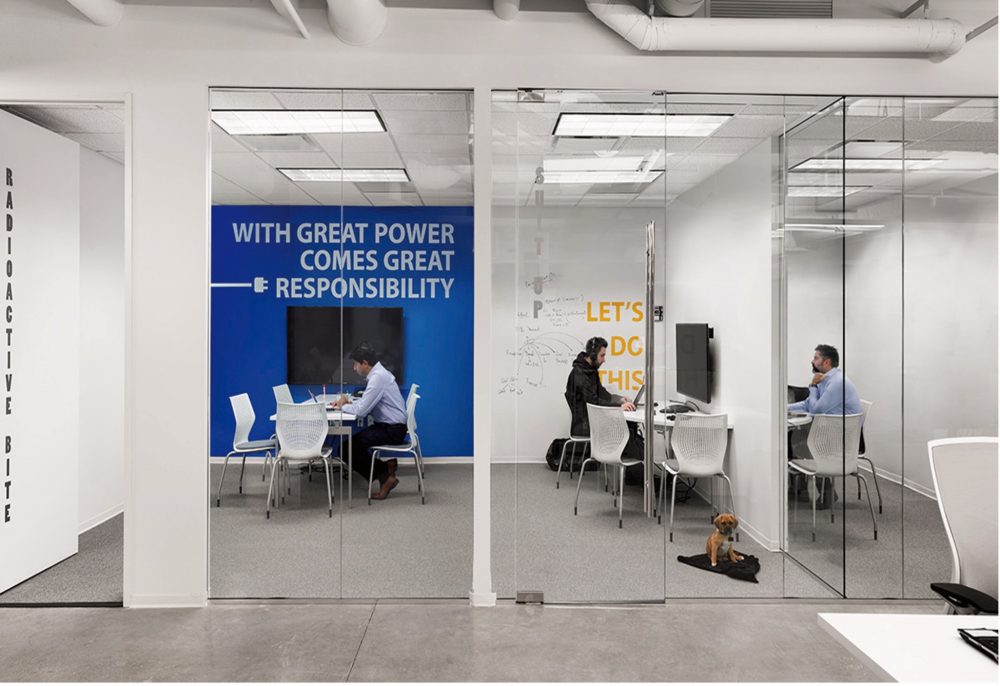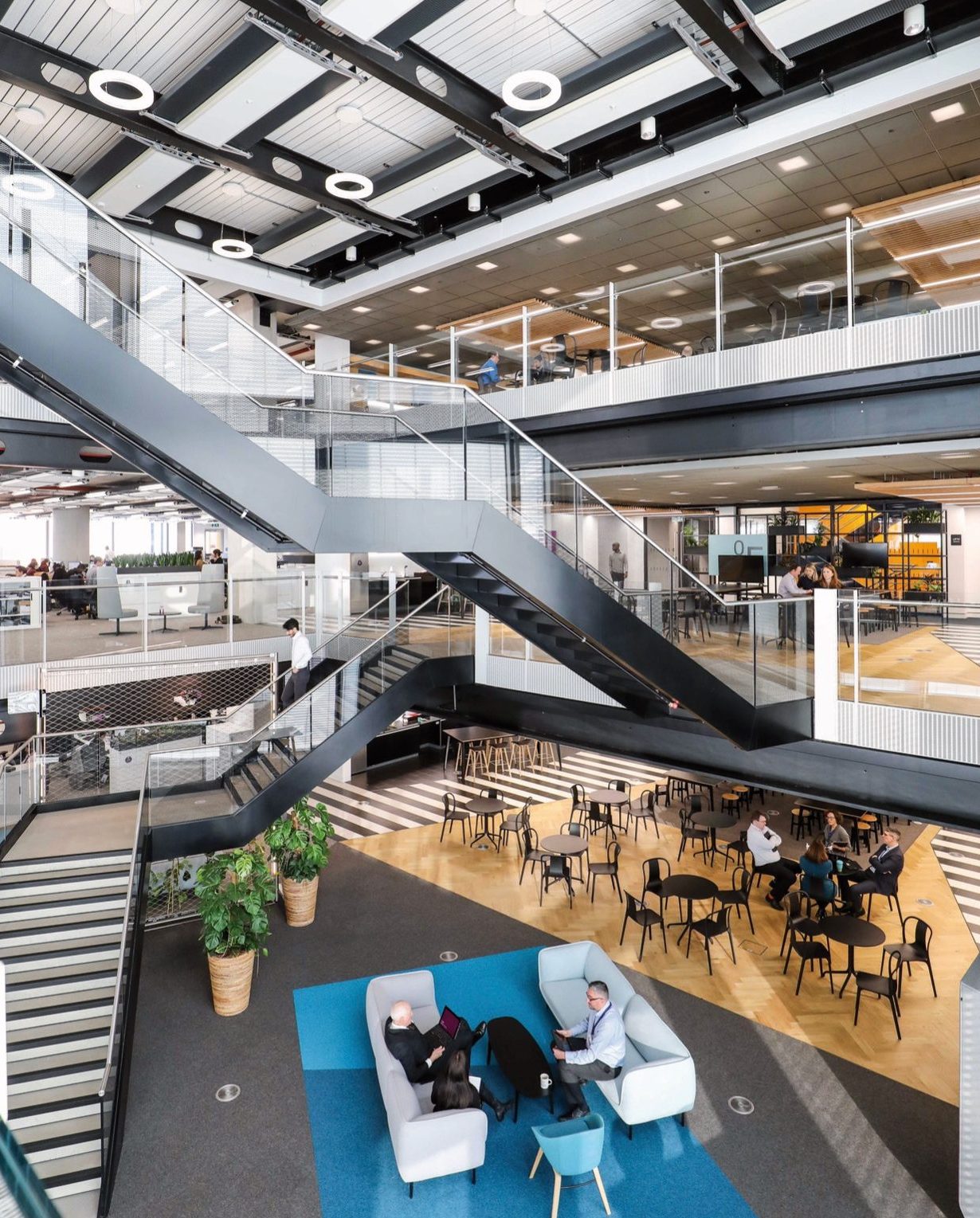Perkins&Will’s Jane Greenthal explores the parallels between the retail industry and workplace strategy and shares six key takeaways.

On March 12, 2020, the Mayor of San Francisco announced lockdown and some of us left jackets hanging on our chairs and unwashed mugs on our desks, not realizing we wouldn’t be back for over a year, if ever…
Some tech firms announced workers didn’t ever have to come back and announced a pivot to a “digital-first” company. Others were frozen with uncertainty, navel-gazing for the “return to normal”. Now the pendulum seems to have swung back and stuck somewhere between return-to-office mandates and an over-hyped “hybrid” workplace that no one seems to agree what that means.
Stepping back, seems we might’ve seen this movie before–in another industry: retail. Granted, it didn’t have the abruptness of the lockdowns and a global public health concern, but it was a disruption that nonetheless reshaped the industry. A nascent online bookseller appeared on the scene in 1994 and in three years went public at a $438 million valuation; three years after that, it hit $1 billion and then doubled its market cap to $2 billion just a year later. Fifteen years later, this start-up called Amazon had a market cap over $250 billion, exceeding that of the largest retailer in the world at the time, Walmart. In its wake, retailers generally did one of three things: 1. Stick their heads in the sand: e-commerce is a passing fad and will never replace stores; 2. Pivot: e-commerce will replace in-store shopping and we have to be digital-only; 3. Go hybrid: maybe there’s room here to capitalize on e-commerce AND in-store shopping.
What if Work 2.0 is an opportunity to rethink our “channels of distribution” to enhance the overall brand (employment) experience?
We know how 1 and 2 played out with a lot of iconic brands (Radio Shack, Sears) going under and a rash of “digital-only” start-ups crowding the space (Pets.com, Drugstore.com). Where we can derive some meaningful lessons are in the companies that chose #3 and saw the value of omnichannel and how to optimize each while finding synergies to improve the overall brand experience. Even brands that started digital-only like Warby Parker, Bonobos, Everlane, Rent the Runway, and even Amazon, eventually went into brick and mortar.
What if Work 2.0 is an opportunity to rethink our “channels of distribution” to enhance the overall brand (employment) experience? It is important to note, however, that not everyone who chose #3 succeeded. Execution is as important as having the right strategy. Having worked with retailers at a variety of scales over the last several years, I see some striking parallels that cross-over to workplace strategy and have derived six key takeaways:
1. Clearly define your brand.
In times of uncertainty, brands have even greater value. It can be a steadfast symbol of something we can trust and rely on. Like a beacon in a snowstorm, it provides a welcome direction. In much the same way, companies need to focus on their brand—essentially their mission and ethos. Employees want a strong sense of purpose and alignment with their values at work, especially when everything seems to be blowing up around us. The most significant manifestation of a company’s brand to its employees is its work culture. The culture must represent the brand and convey its values unambiguously and authentically.

2. Focus on the experience.
It’s not about the transaction. If it were just about buying something or getting work done, we might as well all shop and work virtually. However, it is the experience that draws us to the store or office. It could be social, educational, entertaining, or just an opportunity to physically engage with the brand. But it needs to be truly engaging or enriching to make it worth someone’s effort to get there. It’s not just about the free food, dry cleaning, or barista (remember the escalating corporate “amenity-arms war” prior to the pandemic?) Given the convenience of working from home, it’s less about the amenities and more about who you’ll meet, hang out with… the office is an opportunity to gather formally and informally. The office can be a cultural touchstone that inspires and reminds us why we’re part of the organization. It’s about connection and community.

3. Align the experience with the brand across all channels.
Any disconnect negatively impacts your brand. It doesn’t matter how great the in-store experience is if you’re on hold with customer service for hours. But less obvious is that inconsistencies undermine the credibility and messaging of your brand. I’ve seen a study where playing French music sold more French wines, while playing German music led to less sales and shorter dwell times in the same store. Amazing what our subconscious picks up. Many companies send out mixed messages: we care, but not enough to reimburse for an ergonomic work desk or high-speed internet. It’s always been about walking the talk, but one must also look across all the channels to ensure consistency and, in the workplace, equity and inclusion for workers across platforms is also a key consideration.

4. Optimize for the system, not the components.
I recall a McKinsey article on Customer Experience where the writer observed that getting each component in the value chain 97% right can still lead to a 30% system failure with ten touchpoints. But it’s as much about mindset as it is about process. You can six sigma a process to death, and still lose sight of the big picture and what creates value for your customer /employee. Individual touchpoints matter, but they need to be in the context of an experience that is relevant and meaningful. Traditional retail (workplace) metrics like sales per square foot (USF per employee) need to be replaced with return visits (occupancy), engagement (collaboration, retention), etc. that are more indicative of a compelling experience. Clarify the in-office value proposition for your employees beyond a collection of tools, equipment, technology, or amenities.

5. Put the customer (employee) in the center.
“Human-centered design” seems redundant, yet I see so much design omit the user in the process. Some of it is unintentional with well-meaning designers using the “focus group of one” and their imagination to create an ideal experience. But you need the insights that come from real data to inform design. This means data that is inclusive, and both qualitative as well as quantitative. Working with entities like an international airport, I couldn’t interview and observe everyone, but I could seek out those at the margin—designing for those with the greatest needs often means designing for everyone in between. It always surprised me when retailers didn’t actually talk to their customers, but I’ve found a huge disconnect between leadership and staff with many workplace clients as well. Often, solutions require iteration and pilots are incredibly valuable, but user feedback needs to be actively sought and used.

6. Think outside the box.
Innovative retailers rethought the role of the flagship and experimented with new formats such as pop-ups, mobile experiences, AR/VR, events, and partnering with other brands to create a unique experience. In a similar fashion, employers should rethink the HQ and if they can meet employees where they are or create more compelling destinations using different formats and/or co-location with other businesses.
So, while the movie may have different characters and settings, the plotlines are similar: industry sees disruption, the role of place is questioned, reactions range from denial to radical pivots, great experience proves to be platform-agnostic, and the heroes are the ones who don’t let a good crisis go to waste and redefine the status quo into something much more interesting and delightful.

